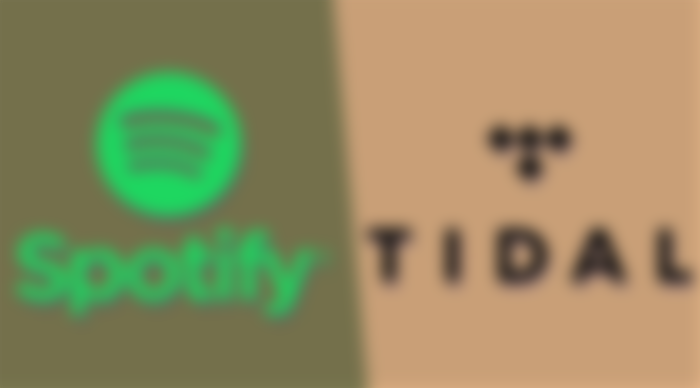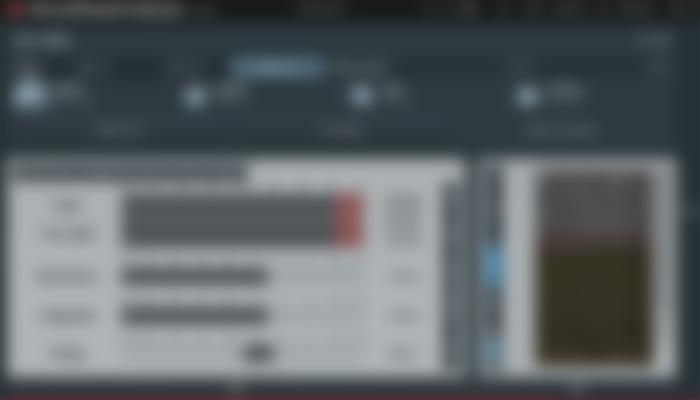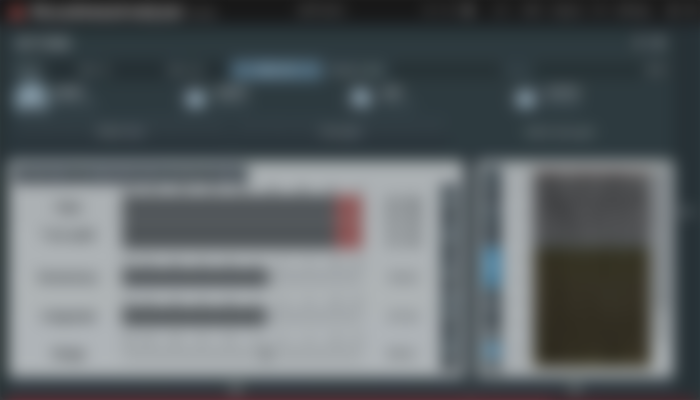Tidal or Spotify? Let's compare two of the music streaming industry's leading platforms with the interpretations of an audiophile.

I sat down and measured the tidal. Let me tell you about tidal or spotify from a boring engineering perspective. Let me give you some information first...
First of all, I have a studio where I record-production etc., equipped with professional equipment (not audiophile toys). I ran my rme brand sound card at 192khz. This device is the most known and widely used name converter in the "mastering grade" class of the market. It also provides digital loopback feature. that is, it allows me to route the sound I want to the input or output I want from the sound card. that is, I can direct the sound playing from Spotify to the program I use for sound recording (daw) without loss. No need for an additional program etc (like voicemeeter).
I turned off volume normalization in tidal and spotify (it plays whatever the recording level is). I have a tidal hifi subscription, I also chose the highest quality on spotify (ogg 320 kbps). I chose 2 songs: one is amy winehouse - back to black, the other is billie eilish - happier than ever.
I recorded these two songs from tidal and spotify. I measured the loudness value and frequency response of the songs.
Billie Eilish's average frequency response of 10 seconds at 8192 resolution with 1/3 octave smoothing:

Points to consider when looking at this chart
1. The pink lines indicate the limits of the human ear. In theory, you can't hear high-pitched sounds above 20khz. in practice, your hearing limit is around 15-16khz if you are over 12 years old, even with a fully linear speaker up to 20khz. If you listen to it carefully in a quiet environment, you will hear it as an ssss sound. In practice, we can think of it as after 15-16khz. You can't hear bass sounds under 20hz in the lower frequencies that can be seen on the left side.
now you can see spotify's compressed ogg format file drops drastically after 20khz and fades out at -112 dbfs around 30khz. Although this means that it can carry sound up to 30khz frequency at -112 dbfs on paper, in reality it is impossible for us to hear levels beyond -60 -70 dbfs. where dbfs is decibel full scale while db is decibel - loudness.
we need to explain it
The measurement of the sound level in the digital environment is with the dbfs unit. its peak is 0. that is, when I say -112 dbfs, we are talking about a sound dynamic range that goes down from 0 to 112 decibels in digital environment.
So how does this happen in the real world? Let's say when we turn on the speaker in front of the computer, if we measure the level of the music playing with a sound intensity meter (spl meter), a level between 70-80 decibels comes out. 85 decibels is pretty high. concerts, for example, are around 110-115 decibels. Hearing damage will occur if you are exposed to a level above 85 db for a long time. 120 decibels of sound is painful.
Now, when your computer converts a digitally generated signal at 0 dbfs level to voltage and sends it to the speakers, I throw the sound over 10. Here, the volume of the sound playing at 0 point in the digital environment is always constant, we change the volume of the sound in the room by changing the level of the loudspeaker that pushes the air in the real world.
For example, when playing at 0 dbfs, we turned the speakers up to 85db. When you bring the sound to -10 dbfs on the computer, the speaker goes down from 85 db to 75 db. When I bring it to -50 dbfs, the speaker plays 35 db. at whisper level.
Now for you to hear a signal at -110 dbfs in digital environment, you need an amp speaker that can produce 110 decibels of sound outside when the sound is at 0 dbfs. This 110 decibel sound has the same intensity as a ship's whistle.
So the point I'm going to reach is... -in sound systems found in 99.9999999% of the listeners- it is impossible to hear sounds below 60 dbfs. Especially in the car, outside, and even if your house is in a central location, it is impossible to hear these sounds in the noise inside the house. Especially in music, in a place where there are louder sounds, it is impossible to hear what is going on at -60 db among them.
it has nothing to do with cable, speaker or headphone etc. a physical event. If the air is not pushed enough, that pressure will not reach your ears and the signal will not go to your brain, and you will not be able to hear anything because your brain cannot interpret the signal that is not coming.
now - if you look at the graph again, we see that the tidal master record goes up to around 50khz. spotify ogg drops rapidly after 20khz. Does this mean tidal allows you to listen to better quality music? no.
the hearing limits of the human ear are 20khz. we don't hear it. If the device you are using does not work at 192khz sample rate, so nyquist does not keep the limit at 96khz frequency, it automatically downsamples it to whatever sample rate it is (for example, iphones' max sample rate is 48khz) and allows you to drop to 24khz as the maximum frequency. it causes. but this is again above 20khz, which is the hearing limit of the human ear. so even if you have a speaker that can push air up to 20khz linearly (without loss), you won't be able to hear it drop to 24khz (because it can't detect on-ear).
In other words, having a high sampling rate in terms of frequency response does not offer you any added value during playback.
if we continue
As someone in the business, I can tell you that 99.9999% of the recordings are made with 48khz sampling rate. what does this mean?
this means: while recording with the microphone to convert the instrument-sound from the real world to digital, the device that converts from analog to digital (adc) is set to 48khz sampling rate. This means that it does not record high-pitched sounds above 24khz. Even if sounds above 24khz are converted to electrical voltage by the microphone, before converting this electrical signal into digital by sampling, it applies a sharp filter (low pass filter) and cuts over 24khz and records the part below it. that is, there is no point in playing a recording recorded with 48 khz from the beginning with a sampling rate over 48 khz anyway.
What you can measure does not mean what you can hear. In music recorded with high sampling rate and bit depth, the instrument that can play the frequencies that make use of these high numbers is limited, and the ear that can hear is even more limited.
what about 16 bit 24 bit mint?
The dynamic range of the 16-bit register is 96 dbfs. I would like to remind you of the ship whistle incident that I told at the beginning.
The 24-bit dynamic range is 144 dbfs. I also compared these two songs in terms of loudness values. There are constantly repeated "tidal sounds more dynamic because 24bit 192khz" comments.
The dynamic range of the line inputs on analog-to-digital converters is 120 decibels. In other words, these devices are already physically limited to around 120 decibels. so wouldn't it be better if we record 24-bit recording at a dynamic range of 120 decibels? yes if it is necessary to record a signal varying from -120 dbfs to 0 dbfs. because the 96 dB range of 16-bit recording will not be able to record the remaining 24 decibels of sound.
But we're talking about music here. for perspective: the dynamic range of standard pop music is only 8-9 decibels. In other words, the difference between the lowest and loudest pop songs you listen to is about 8 decibels. that is, if your song hits the maximum point of 0 while playing, the least it hits is -8 decibels or something.
there is an area of 100 decibels below it. what does this do? The bottom we call noise floor helps to push down the noise. remember the tape cassettes, when you put them on the Walkman, there was a sound like ssssssss? huh, that noise floor. The sound of the electronics of the tape. The dynamic range that cassettes can achieve on the best deck cassette decks with dolby noise reduction is 60 db. When we were young, this was approximately 40 db on our Walkmen.
In summary, 16-bit cd quality is the cleanest recording format after 24-bit with its low noise level of -96 dbfs.
Moreover, when the microphones, pre-amps, room noise, electrical noise etc. we use while recording, the noise floor is already around 80 dbfs. In summary, 16 bits is more than enough and a dynamic range that increases.
now i'm coming back to tidal and spofity
In the measurements I made, I saw that tidal is a 1:1 version of the same master recording, only with higher sample rate and bit depth. There is no such thing as "more dynamic". 1:1 has the same loudness, 1:1 has the same peak to loudness ratio in both formats.
My measurement from the last chorus of the billie eilish song:
spotify

tidal

in summary
Someone who listens to spotify's in high quality mode and then says "tidal is obviously better bro" doesn't know what they're talking about. does not know how digital sampling works. He does not know how the sound he hears is transferred to digital, how it is recreated, and how it reaches our ears.
I bought an expensive instrument, I think I hear better because it works at 768 khz sample rate with very high specifications on paper. does not hear.
it is also very easy to test (daw program and a plugin called hofa blind test are needed). You get the channels, you open the blind test plug-in and randomize it, then you press it occasionally to see if I can hear a difference between the channels.
I can't hear a difference in the blind test, even though I know what I should listen to, in my acoustically arranged room and in my audeze lcd2 headphones, fed by my mastering grade dac that I mentioned earlier, frequency response measurement microphone and dsp-corrected 3-way reference speakers.
If we used test tones designed for this job, I would probably hear the difference. but there is no difference between high quality spotify and tidal master for recorded and mixed music. artists and record companies give the same 1:1 master to all streaming platforms. spotify just compresses the master it bought. The compression technique is also very transparent. visible differences in measurements are also outside the audible range.
In summary yes, high sample rate and bit depth is a format that carries more data mathematically, but 16 bit 44.1khz is more than enough for listening to music - so cd quality is more than enough. because the audible range is limited to 20khz, because people's senses decrease rapidly with age and the effective hearing ceiling is at 15-16khz, because the high dynamic range provided by 24-bit is not a level that we can see the benefit of in the real world.
The main reason for choosing spotify or tidal or any other service should be discovery features, quality of playlists, application stability and compatibility with smart devices (TVs, BT speakers, home theater receivers, etc.) rather than sound quality. The "quality" ceiling was already captured by the cd format standard in the 80s.
*sampling rate issue
We use khz when talking about sampling rate and khz when talking about frequency response.
one is the number of samples taken per second when digitizing the analog signal. (If it samples 44100 times per second, we say 44.1khz sample rate, if it samples 192000 times per second, we say 192khz.)
the other is the frequency value representing the vibration rate of air per second. If we say 20hz, it vibrates 20 times per second, if we say 1000hz, it means 1000 times, if we say 24khz, it vibrates 24000 times. voices vibrate faster as they get higher. 10khz produces a higher pitched sound than 1000hz.
The sampling rate has an effect on the highest sound frequency that can be sampled. You can refer to the nyquist theorem for this. accordingly - in order to convert an analog signal to digital faithfully and convert it back to analog, you need to use at least 2 times the sample rate of the highest frequency signal. so if we want to convert a 10khz signal to faithful digital, we need to use 20khz sampling rate.
44.1khz (cd standard) is between philips and sony as sampling rate which will catch 20khz which is the maximum audible frequency of human ear and will catch 22050hz to make room for an anti aliasing filter effect that will cause distortion at high frequencies a negotiated and chosen standard. who wants more details: wiki



